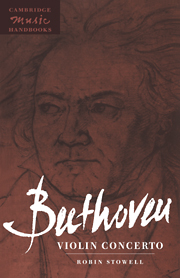Book contents
- Frontmatter
- Contents
- List of figures
- Preface
- 1 Towards the Violin Concerto Op. 61
- 2 The genesis of Op. 61
- 3 Reception and performance history
- 4 The textual history
- 5 Structure and style I – 1. Allegro ma non troppo
- 6 Structure and style II – 2/3. Larghetto – Rondo: Allegro
- 7 Cadenzas
- Appendix 1 Select discography
- Appendix 2 Published cadenzas
- Appendix 3 Textual problems perpetuated in some printed scores
- Notes
- Select bibliography
- Index
3 - Reception and performance history
Published online by Cambridge University Press: 28 October 2009
- Frontmatter
- Contents
- List of figures
- Preface
- 1 Towards the Violin Concerto Op. 61
- 2 The genesis of Op. 61
- 3 Reception and performance history
- 4 The textual history
- 5 Structure and style I – 1. Allegro ma non troppo
- 6 Structure and style II – 2/3. Larghetto – Rondo: Allegro
- 7 Cadenzas
- Appendix 1 Select discography
- Appendix 2 Published cadenzas
- Appendix 3 Textual problems perpetuated in some printed scores
- Notes
- Select bibliography
- Index
Summary
The premiere
Although public concert life in Beethoven's Vienna was unable to match that in the palaces of the nobility, it was nevertheless buoyant in the first decade of the nineteenth century. The concerts were mostly one-off ventures held in appropriate theatres, restaurant salons or multipurpose halls, for, unlike other major European cities such as London, Paris or Leipzig, the Austrian capital did not foster a continuing tradition of public subscription concerts until Ignaz Schuppanzigh's comparatively unambitious Augarten series. Single concerts were either charity concerts (for example, those of the Tonkünstler-Societät from 1772) or benefit concerts for the musician who organised them. It was in such a ‘groβe musikalische Akademie’ for the benefit of Franz Clement at the Schauspielhaus an der Wien on 23 December 1806 that Beethoven's Violin Concerto received its premiere. The first part of the concert also included works by Méhul, Handel and Mozart, while the second part featured works by Cherubini, Handel and Mozart and a further solo ‘spot’ for Clement, in which he followed some improvisations with ‘a Sonata on one string played with the violin upside down’ (see Fig. 3.1).
The Concerto gained a mixed reception. Some critics of the day considered it too long and lacking in continuity. Johann Nepomuk Möser, a man of considerable standing in the social life of his day, wrote:
The distinguished violinist Klement [sic] played, amongst other excellent pieces, also a violin concerto by Beethhofen [sic], which on account of its originality and its many beautiful passages, was received with much approbation. […]
- Type
- Chapter
- Information
- Beethoven: Violin Concerto , pp. 30 - 49Publisher: Cambridge University PressPrint publication year: 1998



